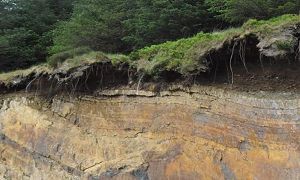ARCHIVED CONTENT: In December 2020, the CZO program was succeeded by the Critical Zone Collaborative Network (CZ Net)
×
CZ Science 5. Water transfer through the Critical Zone
A Pennsylvania cliff, illustrating a cross section of the Critical Zone with trees, soil, and bedrock.
This module teaches how to evaluate the water balance of an ecosystem---a growing challenge as we face increasingly unpredictable water supplies coupled with rising demand for water across all sectors. The module is part of a undergraduate course on CZ Science hosted by InTeGrate SERC.
Grades 15 -
16
Hydrology • WaterChemistry • Biology/Ecology
Curriculum
Educational Objectives
By the end of this module students will be able to:
- Explain the reservoirs and fluxes of water cycling among the different parts of the Critical Zone.
- Analyze the water budget of a catchment that includes both biotic and abiotic processes.
- Calculate water budget components at multiple scales.
- Assess anthropogenic changes to the water cycling in a catchment.
More on this module's objectives can be found here.
Audience
Higher Education
Observatory: National CZO
Author(s): Martha Conklin, SSCZO staff and students (University of California, Merced)
Contact(s):
Funding: National Science Foundation–funded SERC InTeGrate project
Related Resource(s):
- CZ Science 0. Undergrad course (7 modules)
- CZ Science 1. Critical Zone background
- CZ Science 2. Methods of Critical Zone Science
- CZ Science 3. Critical Zone architecture & evolution
- CZ Science 4. Land-atmosphere exchange
- CZ Science 6. Geochemistry & biogeochemistry
- CZ Science 7. Humans in the Critical Zone
Details for this Resource
In this module, students learn about the links between the water cycle and the different components of the Critical Zone. By using mathematical and symbolic models, students will use a systems-based approach to analyze water balance components. Features of this module include the application of an experimental design for water-balance assessment, the use of data gathered by researchers at Critical Zone Observatories, and practice developing a water resource management plan under a given context. The final activity is to develop a water resource allocation plan while acknowledging the trade-offs between the environmental needs and human population needs.
-
Unit 5.1: Water balance of a tree (roots to leaves) (Two 75 min class sessions)
- Students complete a monthly mass balance for water use in a single tree, asking the question: Is there enough water in the soil to account for transpiration?
-
Unit 5.2: Assess water supplies and determine distribution at a regional scale (Two 75 min class sessions)
- In-class discussion focuses on concepts of scaling and conducting hydrologic research across multiple scales. Students complete two activities focused on measurement scaling and water resource management.
Explore Further



